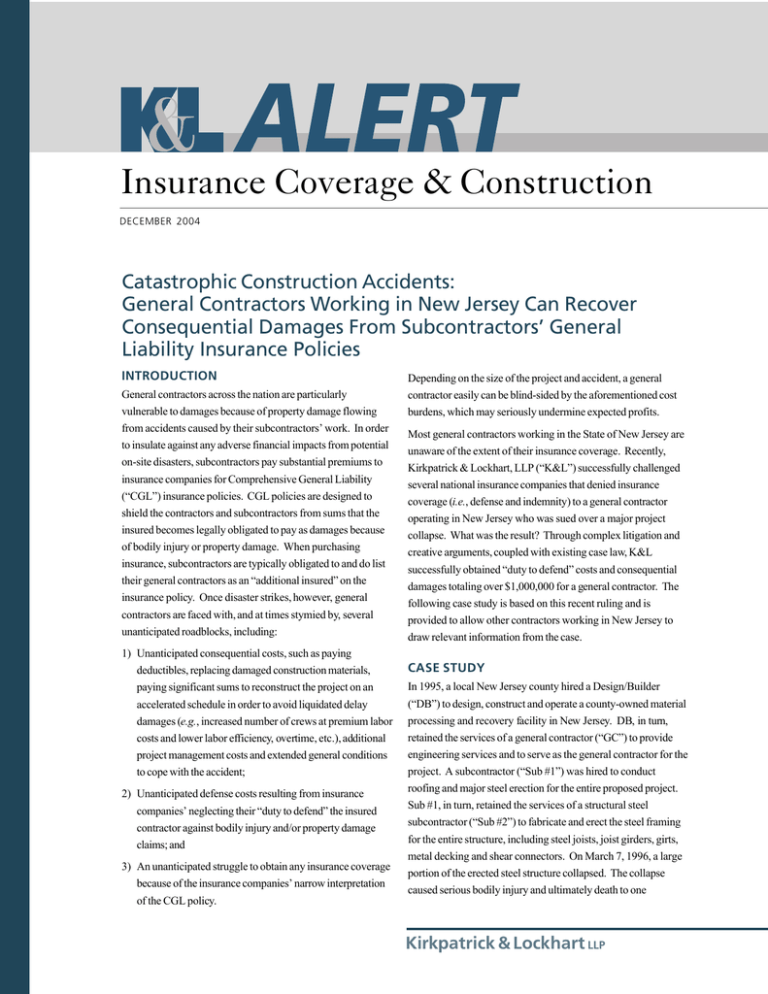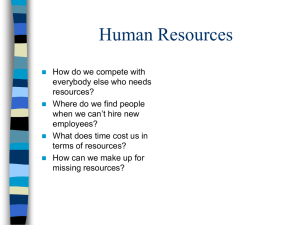
Insurance Coverage & Construction
DECEMBER 2004
Catastrophic Construction Accidents:
General Contractors Working in New Jersey Can Recover
Consequential Damages From Subcontractors’ General
Liability Insurance Policies
INTRODUCTION
General contractors across the nation are particularly
vulnerable to damages because of property damage flowing
from accidents caused by their subcontractors’ work. In order
to insulate against any adverse financial impacts from potential
on-site disasters, subcontractors pay substantial premiums to
insurance companies for Comprehensive General Liability
(“CGL”) insurance policies. CGL policies are designed to
shield the contractors and subcontractors from sums that the
insured becomes legally obligated to pay as damages because
of bodily injury or property damage. When purchasing
insurance, subcontractors are typically obligated to and do list
their general contractors as an “additional insured” on the
insurance policy. Once disaster strikes, however, general
contractors are faced with, and at times stymied by, several
unanticipated roadblocks, including:
1) Unanticipated consequential costs, such as paying
deductibles, replacing damaged construction materials,
paying significant sums to reconstruct the project on an
accelerated schedule in order to avoid liquidated delay
damages (e.g., increased number of crews at premium labor
costs and lower labor efficiency, overtime, etc.), additional
project management costs and extended general conditions
to cope with the accident;
2) Unanticipated defense costs resulting from insurance
companies’ neglecting their “duty to defend” the insured
contractor against bodily injury and/or property damage
claims; and
3) An unanticipated struggle to obtain any insurance coverage
because of the insurance companies’ narrow interpretation
of the CGL policy.
Depending on the size of the project and accident, a general
contractor easily can be blind-sided by the aforementioned cost
burdens, which may seriously undermine expected profits.
Most general contractors working in the State of New Jersey are
unaware of the extent of their insurance coverage. Recently,
Kirkpatrick & Lockhart, LLP (“K&L”) successfully challenged
several national insurance companies that denied insurance
coverage (i.e., defense and indemnity) to a general contractor
operating in New Jersey who was sued over a major project
collapse. What was the result? Through complex litigation and
creative arguments, coupled with existing case law, K&L
successfully obtained “duty to defend” costs and consequential
damages totaling over $1,000,000 for a general contractor. The
following case study is based on this recent ruling and is
provided to allow other contractors working in New Jersey to
draw relevant information from the case.
CASE STUDY
In 1995, a local New Jersey county hired a Design/Builder
(“DB”) to design, construct and operate a county-owned material
processing and recovery facility in New Jersey. DB, in turn,
retained the services of a general contractor (“GC”) to provide
engineering services and to serve as the general contractor for the
project. A subcontractor (“Sub #1”) was hired to conduct
roofing and major steel erection for the entire proposed project.
Sub #1, in turn, retained the services of a structural steel
subcontractor (“Sub #2”) to fabricate and erect the steel framing
for the entire structure, including steel joists, joist girders, girts,
metal decking and shear connectors. On March 7, 1996, a large
portion of the erected steel structure collapsed. The collapse
caused serious bodily injury and ultimately death to one
Kirkpatrick & Lockhart LLP
employee and massive property damage to the structure. Sub
#2 was found to be the sole cause of the accident because it
negligently removed temporary braces before permanent
braces were in place. GC and Sub #1 asserted substantial
claims for damages flowing from the collapse.
Overall, by successfully arguing various legal issues and for a
narrow interpretation of the business risk exclusion provisions in
insurance policy, GC recovered insurance coverage for the
consequential damage flowing from Sub #2’s negligence. All of
the GC’s damages were recovered.
The insurance company in this case denied all of GC’s
insurance coverage claims made as an additional insured under
Sub #2’s CGL policy. The insurance company set forth two
main arguments in support of its insurance coverage denial.
First, the insurance company argued that none of GC’s
damages included actual “property damage” as defined by the
CGL policies; rather, the claims were for uncovered
consequential damages. Second, even if the claims constituted
“property damage,” the business risk exclusions contained in
the insurance policy precluded such insurance coverage. GC
successfully argued to the court that it was an “additional
insured,” that there was a covered occurrence, that the negligent
actions of Sub #2’s steel work caused property damage, and
that no “business risk” exclusions barred insurance coverage.
The successful legal approach employed was both grounded in
existing New Jersey law (e.g., that business risk exclusions
should be interpreted narrowly and that any ambiguity should
be interpreted in favor of the insured) and drew from the
persuasive authority of jurisdictions across the country.
Conclusion
GC recovered consequential damages exceeding $1 million.
GC also recovered its defense costs, which were substantial.
The Insurance Coverage practice group at Kirkpatrick & Lockhart
LLP is one of the nation’s largest policyholder-oriented practices.
Its attorneys have authored Policyholder’s Guide to the Law of
Insurance Coverage and edited the Journal of Insurance Coverage.
FOR ADDITIONAL INFORMATION about these issues, please consult
the authors or any of Kirkpatrick & Lockhart’s office contacts listed below:
National
Boston
Dallas
Harrisburg
Los Angeles
Miami
Newark
New York
Pittsburgh
San Francisco
Washington, D.C.
Peter J. Kalis
John M. Edwards
Robert Everett Wolin
Carleton O. Strouss
David P. Schack
DanielA. Casey
Anthony P. La Rocco
Peter J. Kalis
Thomas M. Reiter
Edward P. Sangster
Matthew L. Jacobs
412.355.6562
617.261.3123
214.939.4909
717.231.4503
310.552.5061
305.539.3324
973.848.4014
212.536.4828
412.355.8274
415.249.1028
202.778.9393
pkalis@kl.com
jedwards@kl.com
rwolin@kl.com
cstrouss@kl.com
dschack@kl.com
dcasey@kl.com
alarocco@kl.com
pkalis@kl.com
treiter@kl.com
esangster@kl.com
mjacobs@kl.com
The number of significant construction projects in the State of
New Jersey involving construction managers and general
contractors continue to rise. With this rise comes an equal and
proportionate amount of corresponding risk. The recent
construction boom in New Jersey and across the country leads to
one unfortunate, yet inevitable conclusion—there will be project
accidents that could cause catastrophic damage. Construction
disasters, such as the above-mentioned case study, illustrate the
fact that general contractors and construction managers must
know their legal rights, must know the extent of their insurance
coverage (including under their subcontractor’s CGL policies),
and most importantly, must never concede the insurance
coverage to which they are entitled.
Under current New Jersey law, contractors have strong
arguments that they can recover damages that flow from the
negligent work of their subcontractors if such work has caused
property damage. General contractors in New Jersey should be
armed with the following information: (1) insurance companies
selling CGL policies will construe those policies as narrowly as
possible; (2) contractors will incur a multitude of unanticipated
consequential and economic costs associated with on-site
catastrophic events; (3) recent legal actions in New Jersey have
construed insurance coverage in certain scenarios to include
consequential damages; and (4) contractors should persist in
attempts to recover such damages. Such vigilance will continue
to solidify the contractor-friendly environment in New Jersey.
ANTHONY P. LAROCCO
alarocco@kl.com
973.848.4014
ROBERT F. PAWLOWSKI
rpawlowski@kl.com
973.848.4032
CHRISTOPHER A. BARBARISI
cbarbarisi@kl.com
973.848.4010
VINCENT P. RAO
vrao@kl.com
973.848.4116
Anthony P. La Rocco is a partner, Christopher A. Barbarisi and
Robert F. Pawlowski are associates, and Vincent P. Rao is a law
clerk resident in the Newark, NJ office.
®
The attorneys resident in all offices, unless otherwise indicated,
are not certified by the Texas Board of Legal Specialization.
Kirkpatrick & Lockhart LLP
Challenge us. ®
www.kl.com
BOSTON
■
DALLAS
■
HARRISBURG
■
LOS ANGELES
■
MIAMI
■
NEWARK
■
NEW YORK
■
PITTSBURGH
■
SAN FRANCISCO
■
WASHINGTON
.........................................................................................................................................................
This publication/newsletter is for informational purposes and does not contain or convey legal advice. The information herein
KIRKPATRICK & LOCKHART LLP INSURANCE COVERAGE ALERT
should not
without first consulting a lawyer. The attorneys
2 be used or relied upon in regard to any particular facts or circumstances
resident in all offices, unless otherwise indicated, are not certified by the Texas Board of Legal Specialization.
© 2004 KIRKPATRICK & LOCKHART LLP.
ALL RIGHTS RESERVED.



